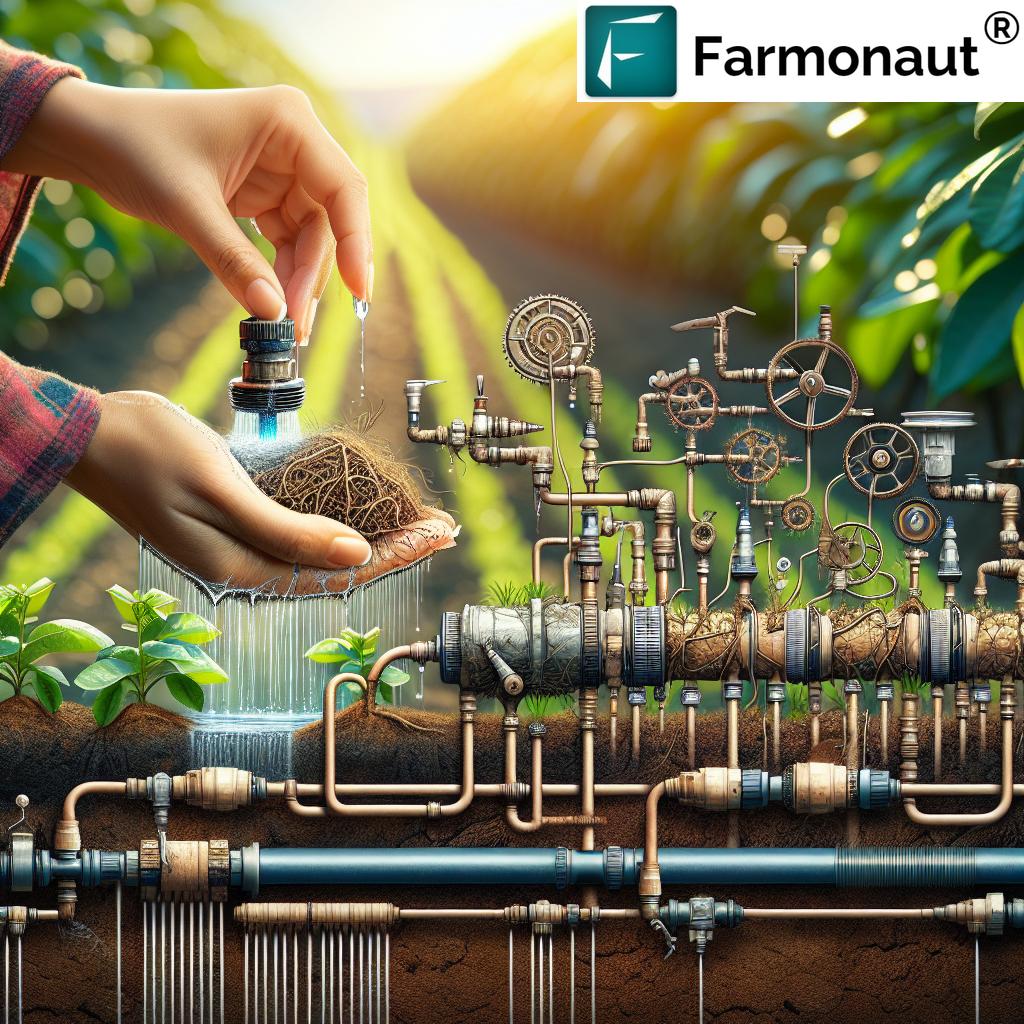Table of Contents
- Introduction to Drip Irrigation System Repair
- Why Drip Irrigation System Maintenance Matters in Modern Agriculture
- Common Issues in Drip Irrigation Systems
- Diagnosing Irrigation System Issues: Methods & Tips
- Drip Irrigation System Repair: 7 Fast Hacks for Efficient Results
- Drip Irrigation Repair Issue & Solution Comparison Table
- Farmonaut’s Advanced Tools for Optimal Drip Irrigation Performance
- Preventive Maintenance: Maximizing Yields & Longevity
- Frequently Asked Questions (FAQ)
- Conclusion
“Did you know? Clogged emitters can reduce drip irrigation efficiency by up to 40% if not repaired promptly.”
Drip Irrigation System Repair: Fix Fast With These 7 Hacks!
Welcome to our ultimate guide on drip irrigation system repair. Whether we manage small-scale gardens or vast commercial farms, keeping our drip irrigation systems in peak condition is essential for conserving water, optimizing yields, and practicing sustainable agriculture. In this comprehensive blog, we’ll cover expert tips for identifying and solving the most common drip system issues, reveal actionable repair hacks, and highlight how advanced tools—like those offered by Farmonaut—can transform our maintenance routines.
Why Drip Irrigation System Maintenance Matters in Modern Agriculture
In the face of water scarcity and the global demand for food, drip irrigation stands out as an efficient method that delivers water straight to plant roots, maximizing resource use while enhancing crop yields. However, this precision comes with a caveat: even minor issues—like clogged emitters or leaks—can degrade system efficiency, cause water wastage, or lead to uneven crop growth.
- Optimized drip irrigation performance requires ongoing visual inspection, cleaning, repairs, and preventive maintenance.
- Farmonaut’s satellite-based solutions empower us to monitor plant health, water distribution, and even pinpoint hidden irrigation issues from above—revolutionizing maintenance practices with real-time data.
Let’s explore how to keep our systems running at peak performance through systematic repairs and best practices.
Common Issues in Drip Irrigation Systems and Their Impact
To restore and maintain optimal drip irrigation performance, it’s crucial to understand the most frequent issues that compromise water delivery to crops. Let’s examine the main culprits:
1. Clogged Emitters
Clogged drip emitters are often caused by sediments, mineral buildup, or biological growth (like algae). These obstructions impede water flow, resulting in plots of plants receiving insufficient water—thereby reducing overall system efficiency and affecting crop health. According to experts, failure to repair clogged emitters can compromise yields by up to 40%.
2. Leaks and Damaged Components
Physical damage from routine agricultural activities, pests, or harsh environmental factors can cause leaks in tubing, connectors, and emitters—leading to significant water wastage and inconsistent pressure. Quick action is necessary to restore system integrity.
3. Water Pressure Irregularities
Fluctuating water pressure—often due to faulty regulators, pump issues, or partial blockages—can result in inadequate (plants receive too little water) or excessive (water logging) irrigation. Uniformity is key for healthy, resilient crops.
4. Filter Blockages
As debris and sediments accumulate in filters, water delivery to the system is restricted. Left unattended, this not only reduces efficiency but also increases the risk of emitters clogging and overall system breakdown.
5. Uneven Water Distribution
Uneven flow can stem from line elevation changes, excessive tubing lengths, or design flaws—leading to dry spots or saturated zones. Careful monitoring and adjustment are required to avoid plant stress.
6. Biological Growth and Algae
Warm, nutrient-rich water invites biological growth like algae, which can obstruct filters and emitters, weaken system integrity, and harm plants by introducing pathogens.
7. Degradation from Environmental Factors
Ultraviolet rays, rodents, root ingress, and freezing weather can damage tubing and connectors, necessitating regular inspection and timely replacement to prevent major outages.
Regular inspection, cleaning, and quick repairs help prevent minor issues from escalating into major, costly breakdowns. Now, let’s look into the best ways to diagnose these irrigation system issues efficiently.
“Regular filter maintenance can extend your drip system’s lifespan by 30%, ensuring consistent water flow and crop yield.”
Diagnosing Irrigation System Issues: Methods & Tips
Diagnosing irrigation system issues early is the best way to prevent costly repairs, save water, and sustain high crop yields. Let’s walk through the top diagnostic methods every modern farmer should use:
- Visual Inspection: Regularly examine plants for signs of water stress—wilting, dry or brown leaves—which indicate uneven water distribution or blockages.
- Pressure Testing: Use pressure gauges to measure water pressure in drip systems at various points; inconsistencies flag leaks, clogs, or faulty regulators.
- Flow Monitoring: Periodically measure flow rates from each emitter or segment. Sudden drops often reveal hidden blockages or leaks.
- Filter Assessment: Inspect filters for debris, sediment accumulation, or mold. Differences in pressure across the filter signal clogging.
- End-of-Line Inspection: Open the ends of main and lateral lines to see if water runs clear, confirming the removal of sediments during flushing.
By integrating these checks into our maintenance routines, we can identify problems early and make data-driven decisions—especially with Farmonaut’s remote sensing technology, which offers real-time crop and field monitoring!
Drip Irrigation System Repair: 7 Fast Hacks for Efficient Results
Looking for efficient, actionable steps to fix your drip irrigation system quickly? Our 7 essential repair hacks—vetted by industry best practices—will help you restore flow, prevent water wastage, and maximize system longevity. Here’s how to fix irrigation leaks, clogged emitters, pressure fluctuations, and more!
1. Regular System Flushing
Why: Flushing prevents and clears clogging caused by accumulated sediments.
How: Periodically open line ends and terminal emitters, allow water to discharge until it runs clear. Repeat after fertilization events or when high levels of debris are detected.
2. Drip Irrigation Filter Cleaning
Why: Filter blockages are a leading cause of reduced flow and emitter clogging.
How: For screen filters, remove and clean using a soft brush or gentle water jet. For sand filters, backflush before each irrigation cycle. Always check for damage—replace as needed for optimal performance.
3. Emitter Cleaning (Unclogging)
Why: Clogged drip emitters drastically affect distribution.
How: Detach emitters, soak in a 1:1 solution of water and white vinegar to dissolve mineral deposits, and gently clean with a small brush or toothpick. Rinse and reinstall.
4. Leak Repairs & Replacing Damaged Tubing
Why: Leaks in tubing or connectors result in water loss and uneven pressure.
How: Identify the leak visually or with pressure drop testing. Cut out the damaged section and insert a barbed coupling or connector to restore system integrity. Secure with clamps for higher-pressure applications.
5. Adjusting and Maintaining Pressure Regulators
Why: Water pressure in drip systems must remain consistent for even distribution.
How: Inspect, adjust, or replace pressure regulators regularly. Monitoring and adjusting regulators as crops grow or layouts change ensures that all plants get adequate water—no more, no less.
6. Chemical Treatments for Severe Clogging
Why: If mineral or biological buildup can’t be removed by flushing or brush cleaning, chemical treatment is necessary.
How: Carefully apply recommended acid or chlorine solutions through lines to dissolve deposits. Always follow manufacturer instructions for safety. This step is especially crucial for systems using groundwater or “hard” water.
7. Winterization & Weatherproofing
Why: Freezing weather can cause tubing and emitters to crack, resulting in leaks.
How: Drain the system completely at season’s end, remove and store sensitive components indoors, and—where relevant—use UV-resistant tubing to prevent sun and pest damage.
Drip Irrigation Repair Issue & Solution Comparison Table
| Issue | Description | Quick Fix Hack | Estimated Repair Time (min) | Tools Required | Efficiency Improvement (%) |
|---|---|---|---|---|---|
| Low Water Pressure | Insufficient flow to all emitters | Check pump/regulator; clean blockages | 20–40 | Pressure gauge, wrench | 20–35 |
| Clogged Emitters | Water drips unevenly to plants | Soak in vinegar; brush or toothpick cleaning | 5–10 per emitter | Small brush, vinegar, gloves | Up to 40 |
| Filter Blockages | Sediments stop water flow | Backflush and clean screens | 10–20 | Brush, hose, bucket | 25–35 |
| Leaks in Tubing | Visible drips or wet patches | Cut & replace with connectors | 10–20 | Pruner, new tubing, coupling | 30–50 |
| Faulty Pressure Regulators | Water pressure fluctuates | Adjust or install new regulator | 15–25 | Wrench, new regulator | 20–30 |
| Biological Growth/Algae | Obstructed lines or emitters | Flush, then use dilute chlorine solution | 30–60 | Chlorine, safety gear, bucket | 15–25 |
| Freeze Damage | Cracks after winter | Drain & store, replace damaged parts | Varies by area | Pruner, new tubing | 20–30 |
This table allows us to prioritize system repairs, estimate downtime, and invest in the right tools—ensuring our irrigation systems function efficiently year-round. Curious to learn more? Explore the vast capabilities of the large-scale farm management suite that simplifies workforce, irrigation, and resource monitoring at any scale.
Farmonaut’s Advanced Tools for Optimal Drip Irrigation Performance
In the era of digital agriculture, having real-time insights on irrigation system performance is a game-changer. Farmonaut enables us to blend hands-on maintenance with satellite-based intelligence, creating the best of both worlds for optimal crop yield and resource management.
- Satellite Crop Health & Moisture Monitoring: Use Farmonaut’s app to visualize areas with water stress or excess, correlate patterns with irrigation issues—and diagnose problems before they escalate.
- AI-Driven Advisory: The Jeevn AI system provides personalized tips on irrigation scheduling, pressure management, and optimal nutrient distribution, tailored to local weather patterns.
- Traceability & Safety: With blockchain-based traceability tools, track the quality and performance of drip components used on your farm, boosting transparency and efficiency.
- Fleet & Resource Management: Manage equipment and labor for rapid repairs with Farmonaut’s fleet management solutions, reducing downtime and improving cost efficiency when maintaining irrigation systems.
- API & Integration: Developers and businesses can integrate Farmonaut data into their own dashboards or advisory systems—see the API developer docs for more!
- Environmental Sustainability: Track and reduce your environmental impact with carbon footprinting tools, directly tied to water use and irrigation practices.
- Insurance & Loan Facilitation: Crop loan and insurance are simplified with real-time, satellite-verified irrigation and health data—helping farmers secure finances faster and more reliably.
Preventive Maintenance: Maximizing Drip Irrigation Yield & Longevity
Preventing drip irrigation system issues is always easier and more cost-effective than repairing them. Here are actionable, sustainable tips for preventing drip irrigation clogging, leaks, and pressure trouble—and ensuring consistent, high crop yields:
- Prioritize Water Quality: Regularly test water sources for sediment, dissolved salts, and organic matter. Install or upgrade filtration as needed to remove contaminants.
- Frequent Visual Inspections: Check all drip lines, emitters, filters, and regulators for leaks, damage, or visible clogs during each irrigation rotation.
- Keep Detailed Maintenance Records: Maintain documentation of system layout, repairs, and maintenance schedules for future reference.
- Upgrade Vulnerable Components: Replace old or sun-brittle tubing, cracked connectors, and worn-out regulators before failure occurs.
- Invest in Weatherproofing: Use UV-resistant and frost-proof materials appropriate for your local climate, and store delicate parts indoors during the off-season.
- Schedule Regular Filter Cleaning: Don’t wait for performance to dip—make filter maintenance part of your regular calendar.
- Use Real-Time Monitoring Tools: Adopt satellite-based technologies like Farmonaut to monitor crop health and catch irrigation system anomalies early.
With proper preventive maintenance, we’ll ensure that our drip irrigation systems deliver water efficiently for years to come—boosting yields, reducing input costs, and supporting sustainable farming goals.
Frequently Asked Questions (FAQ) on Drip Irrigation System Repair & Maintenance
Q1. What is the main cause of clogged drip emitters?
A: The primary causes of clogged emitters are sediment deposits, mineral precipitation (such as from “hard” groundwater), and biological growth like algae or mold. Regular filter maintenance and periodic flushing are effective ways to prevent clogging.
Q2. What type of filters should I use in my drip irrigation system?
A: The choice of filters depends on your water quality. For well or river water, use sand and screen filters. For municipal or very clean water, a screen filter may suffice. Always select filters with a mesh size appropriate for your emitter specifications.
Q3. How can I detect and repair leaks in my drip lines?
A: Look for wet patches along the tubing, dripping water, or visible cracks. Slight drops in pressure or flow rate also indicate leaks. To repair a leak, cut out the damaged segment and use a barbed connector to rejoin the tubing.
Q4. How often should I flush my drip system?
A: Flush your lines at least every 2–4 weeks, or more frequently when using fertilizer injectors or if water has high suspended solids. Flushing after each irrigation cycle is optimal during peak debris or algae periods.
Q5. Can Farmonaut help me monitor my irrigation system?
A: Yes! Farmonaut’s technology uses satellite imagery and AI to monitor crop health, highlight field zones experiencing water stress, and provide actionable irrigation advice—making it easier to maintain optimal system efficiency and boost crop yields.
Q6. How important is water pressure regulation in drip irrigation?
A: Pressure regulation is critical: high pressure can blow out emitters or fittings, while low pressure reduces uniformity of water delivery. Use pressure-regulating valves to maintain consistent, system-appropriate levels.
Q7. What preventive practices extend the lifespan of a drip irrigation system?
A: Core preventive practices include regular system inspection, prompt leak repair, filter cleaning, winterization, and documentation of maintenance activities. Adopting real-time monitoring and affordable precision ag tools like Farmonaut ensures your system runs optimally for years.
Conclusion: Efficient Drip Irrigation System Repair Empowers Modern Farmers
Efficient water use and sustainable crop production depend on well-maintained drip irrigation systems. By embracing effective diagnostic methods, regular maintenance, and prompt repair hacks—from flushing and emitter cleaning to pressure regulation and preventive inspections—we can ensure reliable water delivery, minimize wastage, and maximize yields.
Innovative tools like Farmonaut offer precision monitoring, real-time advisories, and resource management—elevating our irrigation management practices while reducing costs and enhancing sustainability.
Let’s commit to systematic drip irrigation system repair and smart maintenance—empowering us to conserve resources, increase crop productivity, and secure our agricultural future. Start optimizing your farm today with the best in technology and actionable, proven maintenance practices.
For more guides and the latest technology in precision agriculture, stay tuned with Farmonaut—your partner for smarter, sustainable farming worldwide.














